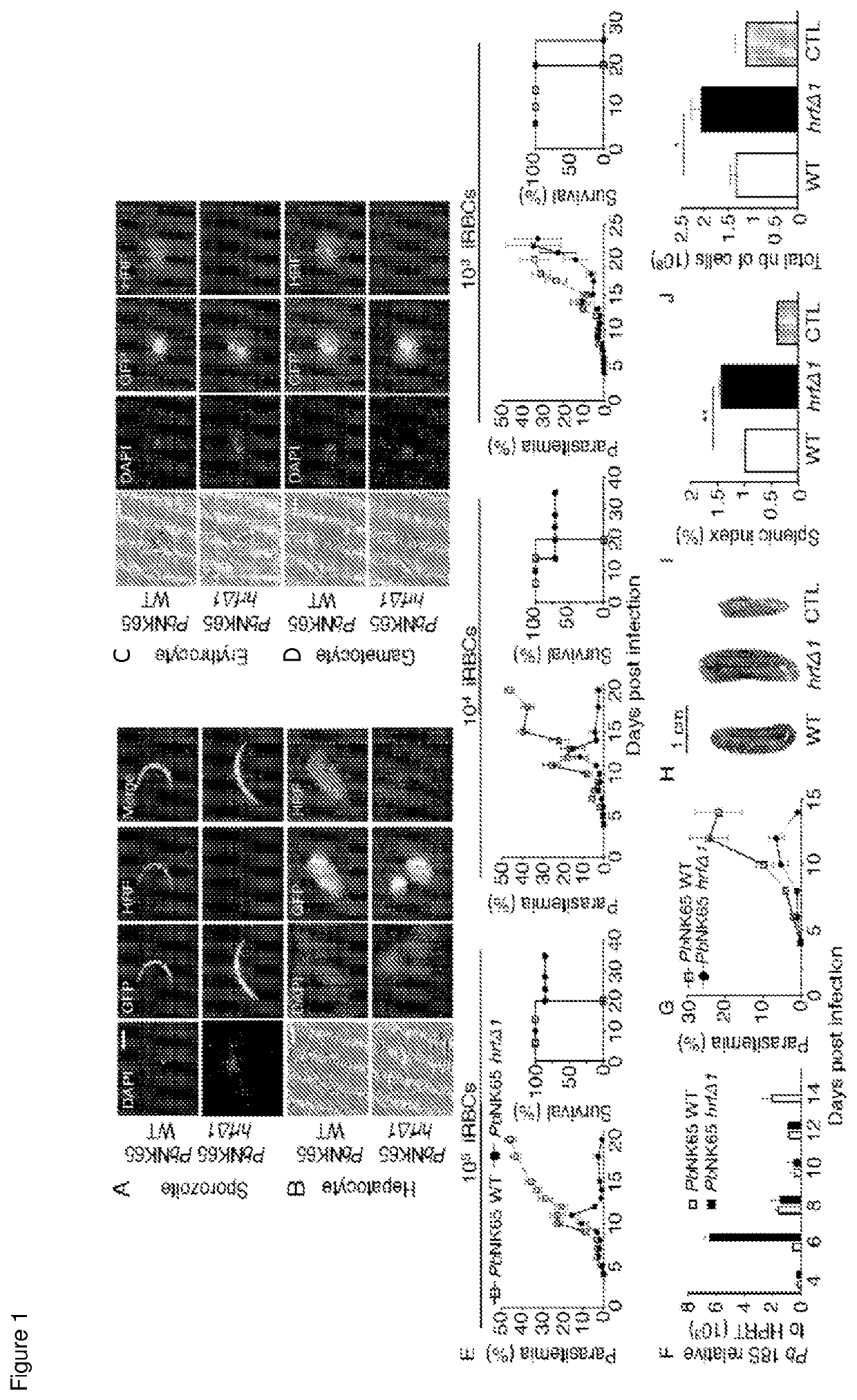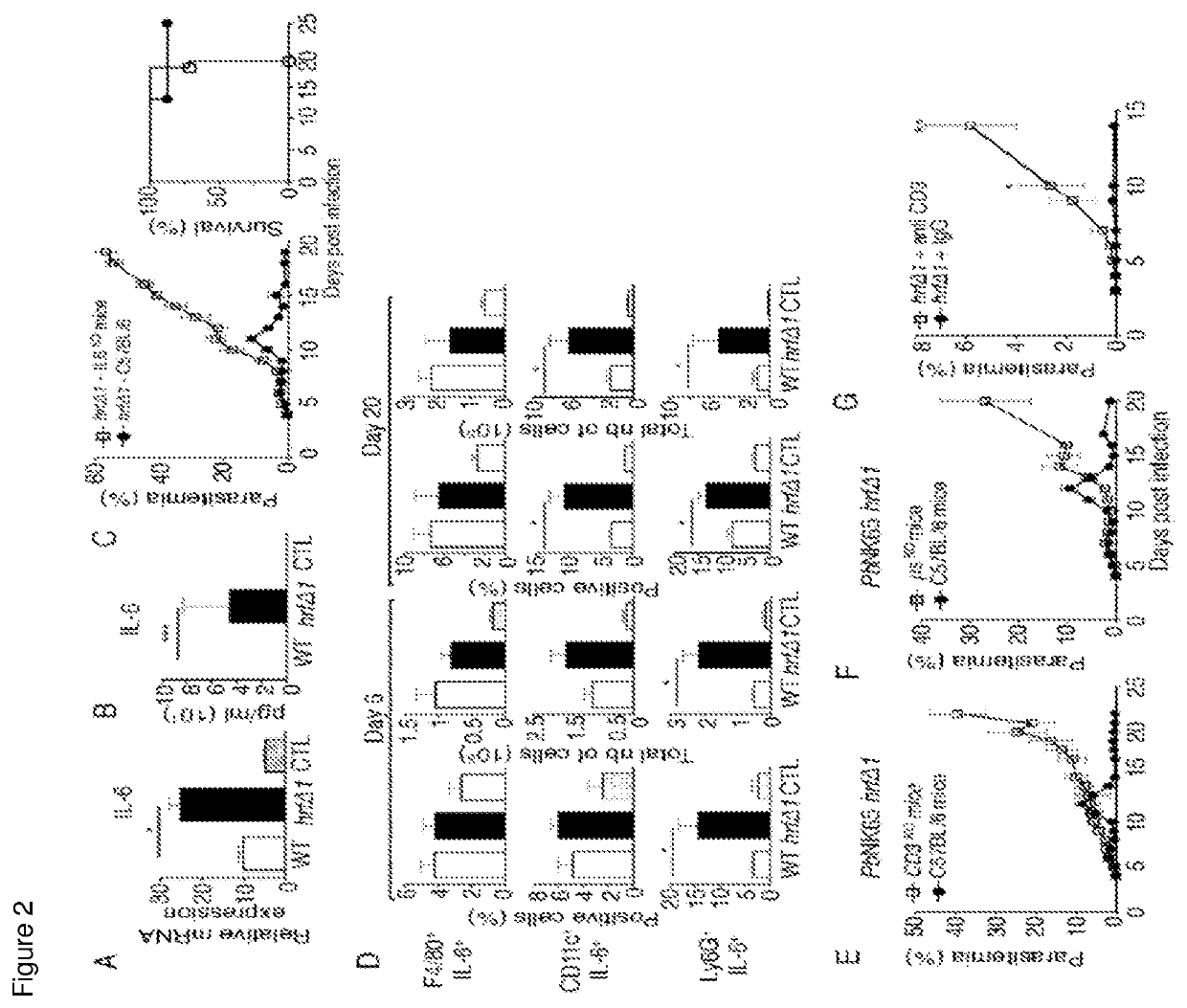Plasmodium with histamine releasing factor (HRF) deficiency for use as a vaccine
a technology of histamine releasing factor and plasmodium sativum, which is applied in the field of plasmodium with histamine releasing factor (hrf) deficiency for use as a vaccine, can solve the problems of serious neurological after effects, complex pathogenesis of cerebral malaria, and still far from being completely elucidated. , to achieve the effect of protecting immune response, protecting immune response, and protecting immune respons
- Summary
- Abstract
- Description
- Claims
- Application Information
AI Technical Summary
Benefits of technology
Problems solved by technology
Method used
Image
Examples
example 1
and Methods
[0166]Rodents. Five- to eight-week-old wild-type female C57BL / 6J Rj and Swiss Webster (SW) mice were purchased from Janvier laboratory (Le Genest-Saint-Isle, France). Transgenic T cell-deficient)(CD3K0, B cell-deficient (secretory μ chain [μsK0]), Fey receptor-deficient (FcyRK0), and IL-6Ko mice strains were kindly provided by Dr B. Ryffel (Institut Pasteur, Paris, France), Dr. J M. Cavaillon (Institut Pasteur, Paris, France), Dr. P. Bruhns (Institut Pasteur, Paris, France), and Dr. Lionel Apetoh (INSERM U866, Dijon, France), respectively. CD11c-DTR-GFP mice (Jung et al., 2002) have been used to explore the role of DCs in controlling parasite development. Transgenic mice have all been back-crossed ten times on C57BL / 6 mice from The Jackson Laboratory.
[0167]Parasites. Mice were inoculated with red blood cells infected (iRBCs) with either Plasmodium berghei (Pb) NK65 wild-type or mutant (hrfl1) GFP-transgenic parasites. In a few control experiments, mice were infected with ...
example 2
of the hrf Gene in PbNK65 Parasites Causes Abortive Blood-Stage Development
[0186]We generated hrf knock-out PbNK65 parasites (PbNK65 hrfΔ) by replacing the coding sequence of pbhrf (PBANKA_111050) with the human dihydrofolate reductase selectable marker (hDHFR) in a GFP-expressing PbNK65 strain (FIG. 5A). Two clones, PbNK65-hrfΔ1-2, were selected from independent transfection experiments and verified to harbour the mutant locus by PCR (FIGS. 5B-D) and Southern blot analysis (FIG. 5E). Using specific rabbit antibodies against recombinant PbHRF (Mathieu et al., 2015), the protein was found to be expressed at all Plasmodium stages tested and to localize to the cytoplasm (FIG. 1A-D), consistent with previous reports in human cells and PbANKA parasites (Bhisutthibhan et al., 1999; Mathieu et al., 2015). HRF was not detected in PbNK65-hrfΔ1 parasites (FIG. 1A-D), confirming both antibody specificity and successful gene knockout.
[0187]To assess the effect of pbhrf deletion on parasite bloo...
example 3
ells and T Cells are Critical for Inhibition of PbNK65-hrfΔ Blood-Stage Growth
[0189]Since HRF-deficient PbANKA sporozoites induce IL-6 production in the liver during pre-erythrocytic infection (Mathieu et al., 2015), we compared IL-6 levels in mouse spleens 6 days p.i with WT or PbNK65-hrfΔ1 iRBCs. Levels of IL-6 mRNA and plasmatic IL-6 protein were higher in PbNK65-hrfΔ1-infected mice than in WT-infected mice (FIG. 2A, B). Given that recombinant PbHRF protein is sufficient to down-regulate IL-6 expression in vivo (Mathieu et al., 2015), we tested whether clearance of mutant parasites was the consequence of elevated IL-6 by infecting IL-6Ko mice with mutant parasites. Mutant parasites developed normally in, and eventually killed IL-6Ko mice (FIG. 2C), phenocopying WT parasite behavior in WT mice (FIG. 1E). We conclude that increased IL-6 accounts for mutant parasite clearance.
[0190]Immunostaining with leukocyte surface markers and anti-IL-6 antibodies of cells collected from the spl...
PUM
| Property | Measurement | Unit |
|---|---|---|
| Sequence Dectection System Real Time PCR | aaaaa | aaaaa |
| temperature | aaaaa | aaaaa |
| Sequence Dectection System Real Time PCR | aaaaa | aaaaa |
Abstract
Description
Claims
Application Information
 Login to View More
Login to View More - R&D
- Intellectual Property
- Life Sciences
- Materials
- Tech Scout
- Unparalleled Data Quality
- Higher Quality Content
- 60% Fewer Hallucinations
Browse by: Latest US Patents, China's latest patents, Technical Efficacy Thesaurus, Application Domain, Technology Topic, Popular Technical Reports.
© 2025 PatSnap. All rights reserved.Legal|Privacy policy|Modern Slavery Act Transparency Statement|Sitemap|About US| Contact US: help@patsnap.com



